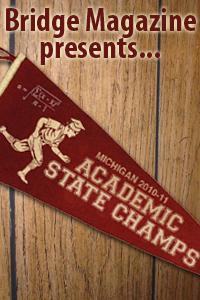Small schools dominate championships
With 171 students, Northport Public Schools has fewer kids in kindergarten through 12th grade than Okemos High School has in its marching band alone.
Mackinaw City has 187 students; Alba, 174; Stanton Township, 138.
All are tiny. All are poor -- as judged by the percentage of students receiving federal free lunch assistance.
And all scored better in 4th grade math than larger, richer school districts across Michigan.
In fact, poor rural districts beat the pants off richer districts in seven out of eight academic categories in Bridge Magazine’s Academic State Championships.
BRIDGE DATABASE: See how your district is doing
BRIDGE GALLERY: Images of success
Using a database of school statistics compiled by Public Sector Consultants and the Citizens Research Council, Bridge Magazine is honoring Michigan’s Academic State Champions in eight academic categories. Just like in the state’s football playoffs, the schools are split into eight divisions, by type of community (city, suburban, rural) and by percent of free lunch.
 Additional coverageLibrary investment pays off for Lakeshore Southfield wins graduation 'game' Three cheers for academic success |
And after all the numbers were crunched, College Readiness (as judged by ACT proficiency) was the only academic category in which a non-rural school (Bloomfield Hills) scored the highest in Michigan. Even in that category, small, rural Houghton-Portage finished second.
Adams Township -- a neighbor to Houghton-Portage on the Keweenaw Peninsula -- with 433 students in kindergarten through 12th grade had the highest percentage of eighth-graders scoring proficient or better on the science section of the Michigan Educational Assessment Program (MEAP) test in fall 2010.
The highest 8th grade math proficiency scores were found in Walkerville, enrollment 319.
Twenty-one school districts tied for the Academic State Championship in 4th grade math, with 100 percent of students scoring proficient or better. Of those 21 districts, all are rural, and 15 are classified as poor and rural schools.
What's going on in the hinterlands?
The rural-school routs could be the result of small sample size. A group of smart kids can vastly improve scores in a small district, but would barely move the needle in a high school of 2,000. Some poor, rural schools scored consistently near the top of academic categories in Bridge’s analysis, but others were at the bottom. Larger schools often were packed in the middle.
Most educators who spoke with Bridge about the Academic State Championships agreed that small schools have advantages that money can’t buy.
"When you go to these rural schools, they don’t have 27 Advanced Placement courses and eight foreign languages” like those that are available to students in Bloomfield Hills School District, said Bloomfield Hills Superintendent Rob Glass. “But they’ve found a way to be really successful. There’s not one right way to do things.”
In a district with fewer than two dozen fourth-graders, kids can’t hide in the back of a classroom, said Amber Ellis, third-grade teacher in Atlanta Community Schools, enrollment 306. Atlanta, located halfway between Gaylord and Alpena, tied for the overall top score in 4th grade math proficiency, with 100 percent of its students scoring at proficient level or higher.
“In a rural school, every day is a parent-teacher conference,” Ellis said “You see the parents in the grocery store and churches. You get children and you recognize how they act because their mother acted the same way when she was in school.”
On top in the U.P.
Adams Township School District was the overall champ of 8th grade science, with 96.3 percent of its students scoring at proficient or higher on the fall 2010 MEAP exam. Finishing second was Forest Hills Public Schools, with 96.1 percent; Ashley Community Schools (96 percent) was third.
“We’re a small school, so we’re like family,” said Jennifer Pera, science and math teacher at Adams Township. “We can catch those kids who might fall through the cracks in a bigger school.”
Another technique employed at Adams: a lake as a classroom. “We snow-shoe out there, we take water samples out there; we do a frog survey every spring,” said Mike Benda, assistant principal at Adams Township’s Jeffers High School. “We have cutting-edge equipment for water sampling and soil sampling and anemometers from donations (by an Adams Township resident). “If we need something, we can get it.
“There’s community support for the science program,” Benda continued. “It’s the type of area it is. We’re a logging and tourist area. They want their kids to learn about the natural environment.”
In the regular classroom, students use electronic clickers to answer questions, letting teachers know immediately whether the minds are understanding the lessons.
“Even the kids who don’t participate (in classroom discussion), they can participate with a clicker and we can tell if they know what I’m talking about,” Pera said. “The technology, combined with the labs (at the lake) and the fact that we’re a small school, maybe that all came together at the right time and space."
Another peninsula, another winner
Northport is a poor school district in a rich area. It overlooks Grand Traverse Bay near the tip of the Leelenau Peninsula and serves a community of farmers, blue-collar families and migrant workers.
“Our families don’t have boats down in the harbor," noted Northport Superintendent Jeff Tropf. “If you’re expecting parents to educate kids, well, that works in some cases and doesn’t work in others.
But that’s not an excuse,” Tropf added. “We don’t accept that. We maximize our time. While we have them, there are our expectations.”
And those expectations are high. Northport tied with 20 other rural school districts for the top score in the state in 4th grade math proficiency, with 100 percent of its students scoring at proficient or higher on the MEAP.
Northport also tied for the state’s top score in 4th grade reading, and was Bridge Magazine’s Division 8 State Champion for College Readiness.
At Northport, 30 percent of high school juniors last fall were proficient on all four categories of the ACT, the highest percentage among poor rural schools. Second was Caseville Public Schools, with 28 percent. The average among all state school districts was 17 percent.
"When you have a community where everyone knows everybody, it helps,” Tropf said. “It’s a tough economy for everybody. Instead of looking at the challenges, we look at the opportunities. Why can’t every child be proficient? You can do well if you captivate kids.”
8th Grade Science Champions
The divisional winners for 8th Grade Science are:
Mona Shores, Division 1
Niles, Division 2
Forest Hills, Division 3
Lakeshore (Berrien County), Division 4
West Ottawa, Division 5
Houghton-Portage, Division 6
Ashley, Division 7
Adams Township, Division 8
4th Grade Math Champions
The divisional winners for 4th grade Math are:
Ann Arbor, Division 1
Godwin Heights, Division 2
Forest Hills, Division 3
Edwardsburg, Division 4
Vandercook Lake, Division 5
Pewamo-Westphalia, Division 6
Brimley, Rapid River, Harbor Beach, Chassell Township and Mackinaw City, Division 7
Alba, Atlanta, Deckerville, Litchfield, Caseville, Stanton Township, Northport, Fairview, Ewen-Trout Creek, Pinconning, East Jordan, Carson City-Crystal, Wakefield-Marenisco, Boyne Falls, Ellsworth, Division 8
Selecting the champs
To crown “Academic State Champions,” Bridge Magazine used the following techniques:
* For rankings in 8th grade math, science and reading and 4th grade math, reading and writing, Bridge compared the percentage of students scoring at or above proficiency standards on the Michigan Educational Assessment Program (MEAP) from the 2010-11 school year.
* For college readiness rankings, Bridge compared the percentage of juniors earning proficient scores in the four academic categories of the ACT in 2010-11 school year; Students needed to earn proficient scores in English, math, science and reading to be considered college-ready.
* For graduation rankings, Bridge compared the four-year graduation rates (the percent of freshmen who graduate in four years) for 2010, the most recent year available.
Bridge placed school districts in division by community type and socioeconomic status.
Districts were divided into city, suburban and town/rural by designations made by the National Center for Educational Statistics. Schools were further split by percentage of free lunch, a commonly used indicator of poverty level. Schools were divided as follows:
Below 20 percent free lunch, 20 percent-40 percent free lunch and above 40 percent free lunch. Because there were only three city school districts with below 20 percent free lunch, those schools were included in the affluent suburban division.
The divisions are:
Division 1: City school districts with 20 percent-40 percent free lunch.
Division 2: City school districts with over 40 percent free lunch.
Division 3: City and suburban districts with under 20 percent free lunch.
Division 4: Suburban districts with 20 percent-40 percent free lunch.
Division 5: Suburban districts with over 40 percent free lunch.
Division 6: Rural/town districts with under 20 percent free lunch.
Division 7: Rural/town districts with 20 percent-40 percent free lunch.
Division 8: rural/town districts with over 40 percent free lunch.
Editor’s note: Detroit Public Schools, because of its size, did not have a true peer group and was left out of the championships. Bridge will hold a separate championship for schools within Detroit at a later date.
See what new members are saying about why they donated to Bridge Michigan:
- “In order for this information to be accurate and unbiased it must be underwritten by its readers, not by special interests.” - Larry S.
- “Not many other media sources report on the topics Bridge does.” - Susan B.
- “Your journalism is outstanding and rare these days.” - Mark S.
If you want to ensure the future of nonpartisan, nonprofit Michigan journalism, please become a member today. You, too, will be asked why you donated and maybe we'll feature your quote next time!

